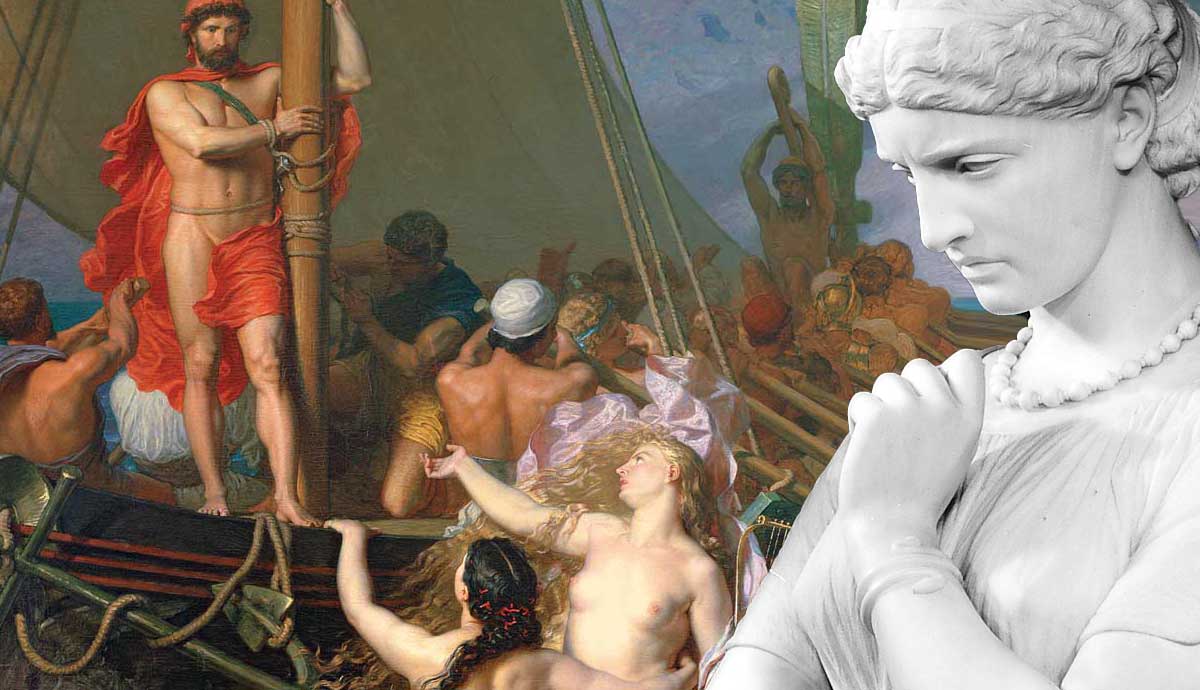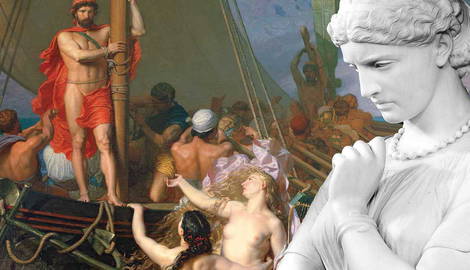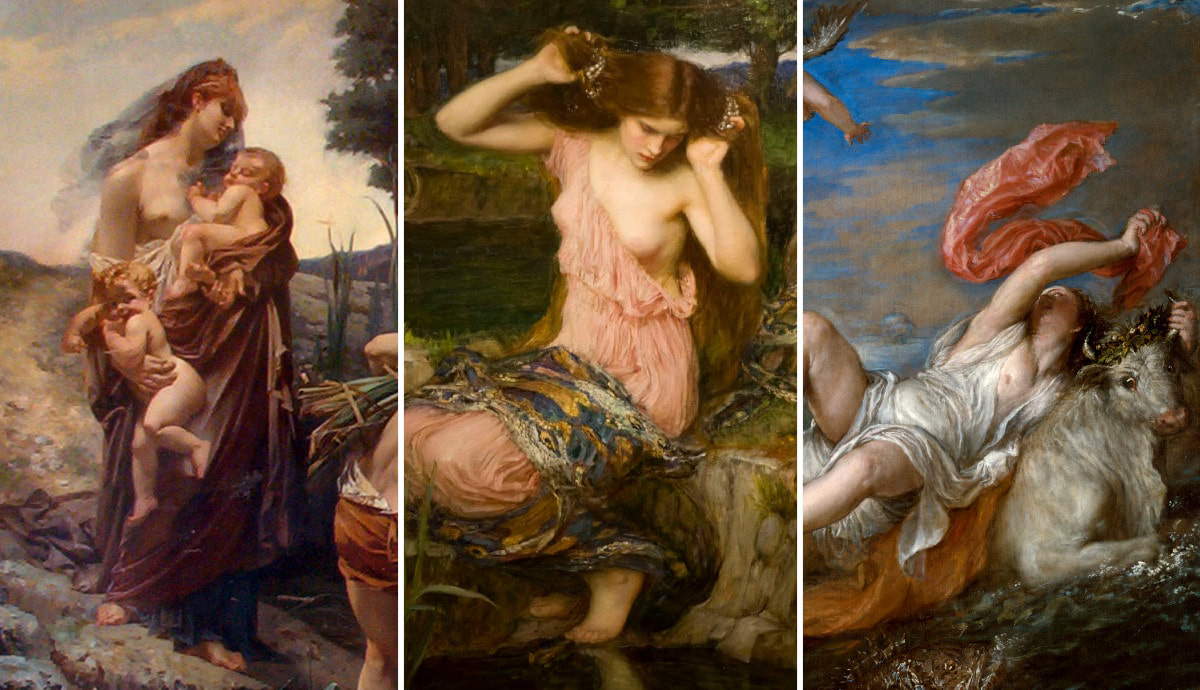
The femme fatale is a character archetype found across many different cultures and mythologies – and Ancient Greek mythology is no exception. A dangerous, seductive, and beautiful woman, examples of the femme fatale abound in Greek myths. From the theodical foundation myth of Pandora, the first human woman to be created by Hephaestus, beautiful women prove disastrous for the men they seduce and are a staple of Greek mythology. Here are seven examples of the many femme fatales that Greek mythology has to offer.
1. Helen of Troy

While she is also occasionally known as Helen of Argos or Helen of Sparta, it is the Trojan War that secured Helen of Troy’s lasting infamy. The daughter of the mortal woman Leda, who conceived Helen after being raped by Zeus in the form of a swan, she was famed for her beauty. And so when Paris was asked to decide who was the fairest among Hera, Athena, and Aphrodite; and Aphrodite promised to give him Helen, the most beautiful woman in the world, if he chose her; needless to say, Paris accepted the goddess of love’s bribe, thus catalyzing the Trojan War.
It is unclear whether Paris abducted Helen or whether she eloped with him willingly. In Homer’s Iliad, which focuses on the Trojan War, she is presented as remorseful and largely passive, though ultimately more concerned with how her part in the war will affect how others perceive her. On some surviving ancient Athenian vases, however, Menelaus is portrayed brandishing a sword and thus as threatening and potentially violent towards her, while on another vase by Makron, Paris clasps her wrist in his hand like a manacle, suggesting her unwillingness (or at least her passivity) when captured.

However, Paris was not the first man to abduct her. In her youth, she had many suitors and was abducted by Theseus, the founder and king of Athens. When she was old enough to marry, Tyndareus (Leda’s husband) was wary of choosing a husband for her, lest he offend the other suitors and so create enemies for himself. On Odysseus’ suggestion, all of Helen’s suitors swore an oath, pledging them to assist the winner if anyone abducted Helen or picked a quarrel with him. Menelaus was then chosen to be Helen’s husband, though he had not attended the competition in person, sending his brother Agamemnon in his stead.
Helen of Troy’s beauty has become legendary, and it is for this that she is arguably the quintessential femme fatale, regardless of whether she was a victim of the will of Paris and the Ancient Greek gods or not. After all, in Christopher Marlowe’s play Doctor Faustus, when the play’s eponymous anti-hero conjures her spirit, he utters some of the most famous lines in English verse: “Was this the face that launched a thousand ships / And burnt the topless towers of Ilium?” (see Further Reading, Marlowe, 12.81-82). Implicit in these lines is the idea that Helen of Troy, by virtue of her beauty, was responsible for the fall of Troy and the deaths of many Greeks and Trojans alike. Just as her beauty entices (that is, corrupts) Paris and Theseus, so too is she indicative of Doctor Faustus’ moral corruption – or so we might be led to believe.
2. Clytemnestra

Though not considered quite as beautiful, Helen of Troy’s sister, Clytemnestra, is widely portrayed as far more actively evil. Where Helen disobeyed Menelaus (be it wilfully or unwillingly), Clytemnestra killed her husband, Agamemnon, Menelaus’ brother.
While this is typically presented as a crime of unparalleled evil in Ancient Greek mythology, Clytemnestra arguably has good cause to take revenge on Agamemnon. On his voyage to Troy, Agamemnon incurred the wrath of the goddess Artemis after killing one of her sacred stags, for which offense she prevents the Greeks from setting sail by sending an unfavorable wind. In order to atone for his offense, Agamemnon is told he will have to sacrifice his daughter, Iphigenia. Without telling his wife of this, he tricks Clytemnestra into sending their daughter to him in Aulis on the pretext that she is to marry Achilles. When Iphigenia arrives, he duly sacrifices her and then sets off to fight the Trojan War.
Clytemnestra, understandably, is devastated by the death of her daughter. During the decade-long Trojan War, she takes Aegisthus as her lover, and the two plot revenge on Agamemnon to be exacted when he returns home from the war. In Aeschylus’ dramatic retelling of the myth, Clytemnestra welcomes Agamemnon home only to entangle him in a net while he is bathing and, while he is trapped, fatally stabs him. In turn, she is killed by her and Agamemnon’s son Orestes, who avenges his father’s murder.
Not only is Clytemnestra’s anger with Agamemnon after he sacrifices Iphigenia understandable, but according to Euripides’ play Iphigenia at Aulis, Agamemnon also killed Clytemnestra’s first husband (Tantalus, the King of Pisa) and her infant son. He then raped her and forced her to marry him.
3. Circe

The daughter of Helios, the god of the sun, and Perse, an Oceanid nymph, Circe was a minor goddess, though she is perhaps more famous as an enchantress. In Homer’s Odyssey, she lives on the island of Aeaea, where she lures Odysseus’ men (save for Eurylochus) to her island and turns them into swine by giving them food and wine laced with her potions.
As an indication of his heroism, Odysseus then subdues her by drawing his sword as if to attack her, doing so on the advice of the god Hermes, who also gives him the magical herb moly to protect him against Circe’s witchcraft. Odysseus stays on Aeaea as Circe’s lover for a year before making his journey to the Underworld so he might learn how to appease the gods and so return to Ithaca.
Circe does not only turn Odysseus’ men into swine, however. In many other stories connected to her, she is presented as a spurned would-be lover who uses her magical powers to take revenge on men who do not requite her love. For example, according to Hyginus and Ovid, the prophetic sea god, Glaucus, was in love with a mortal woman named Scylla, who did not return his affections. Glaucus then turned to Circe and her witchcraft, asking her to concoct a potion that would cause Scylla to fall in love with him. Circe, however, fell in love with Glaucus. When he rejected her, Circe decided to take her revenge by poisoning the waters in which Scylla used to bathe. When Scylla entered the water, she was turned into a monster.
4. Scylla

The earliest surviving text to mention Scylla is Homer’s Odyssey, in which she is depicted as a monster who kills six of Odysseus’ men as they attempt to make their way back to Ithaca. Later ancient writers then fleshed out the myth by giving a background story to Scylla, such as the myth described by Hyginus. According to Servius, she was a beautiful naiad beloved by Poseidon and was turned into a monster by the jealous nereid Amphitrite in much the same way as Hyginus suggests Circe turned her into a monster.
In Greek mythology, it is typical for nymphs to be pursued by male deities in whom they are not interested and then either be rescued or punished by another god for the male deity’s pursuit. It is, therefore, something of a cruel irony that the term “nymphomaniac” has now been taken to signify a woman with ungovernable or excessive sexual desire. Much like Helen of Troy, however, it was Scylla’s sexual attractiveness that made her a threat, for which she was punished. Thus, even in her monstrous state, Scylla can be understood as a femme fatale.
5. The Sirens

Scylla is not the only monster Odysseus meets on his journey back to Ithaca. He also must escape the Sirens, who lure men to their deaths through their song. In Homer’s Odyssey, it is their song, rather than their beauty, that provides the fatal temptation, as Homer neglects to mention their physical appearance. In Apollonius of Rhodes’ Argonautica, they are presented as part woman, part bird. Nonetheless, they have gone down in history as the epitome of the dangerous and beautiful woman – that is, as the femme fatale.
6. Medea

A descendent of the sun god Helios and Circe’s niece, it is somewhat ambiguous as to whether Medea should be understood as mortal or divine. Arguably, this ambiguity adds to the sense of mystery and danger that surrounds her and secures her place as one of the quintessential femme fatales of ancient Greek mythology.
In the myth of Jason and the Golden Fleece, however, she assumes another archetypal role, which is wildly dissimilar to that of the femme fatale: the helpful maiden. Medea falls in love with Jason and is instrumental in helping him complete his quest to retrieve the Golden Fleece, though she must betray her father to do so. Upon Jason’s return to Greece, he and Medea marry, though Medea is then condemned to a life as a foreigner, unable to ever return home after betraying her father.
Despite the service she has rendered Jason and her dependence on him, he betrays her by also marrying Creusa, the daughter of King Creon of Corinth. In Euripides’ dramatic retelling of the myth, Jason justifies this decision, stating that his new marriage will be socially expedient for his and Medea’s sons, helping them to rise through society. Nonetheless, Medea decides that the best possible method of revenge will be to kill their sons – even though doing so is heartbreaking for her, too.
While Euripides’ portrayal of Medea somewhat humanizes her by focusing on the emotional struggle she faces in killing her own children, the ambiguity surrounding Medea’s status as a mortal or a minor deity of sorts adds to our sense that the normal rules do not apply to her. It is Medea’s existence outside the realm of typical human morality that makes her such a dangerous femme fatale.
7. Medusa

One of the three gorgons, Medusa can turn men to stone by looking them in the eye and is described by Aeschylus as being “winged / With snakes for hair” and harboring a deep “hatred of mortal man” (see Further Reading, Aeschylus, 2009, p. 531). In later myth retellings, however, she was portrayed as both beautiful and monstrous.
Writing in 490 BCE, for example, Pindar bestows on her the epithet of “fair-cheeked” (see Further Reading, Pindar, p. 87). And, as Ovid states in Metamorphoses, she had been a beautiful mortal maiden until Neptune (Poseidon) raped her in Minerva’s (Athena’s) temple, for which Minerva turned her into a hideous gorgon by way of punishment for the desecration of her temple.
Given this backstory, however, it is not difficult to interpret Medusa as a victim, first of Poseidon and then of Athena, who also helps the hero Perseus to behead Medusa by giving him a mirrored shield allowing him to see her without looking directly at her. At the time of her death at the hands of Perseus, she is pregnant with Poseidon’s child, and the winged horse Pegasus and the giant Chrysaor are born from her dead body.
As many of these examples demonstrate, the femme fatale is a much-maligned figure in many of the stories of Greek mythology, too often made to take the blame for the actions of powerful men. From sisters Helen and Clytemnestra, both of whom were abducted and assaulted according to some mythical iterations, to Medusa, who is punished by a female god for being a rape victim of a male god, the women demonized in Greek mythology are often more sinned against than sinning. The femme fatale, then, is not quite as simplistic a character archetype as it may initially seem in Greek mythology.
Further Reading:
Aeschylus, The Three Theban Plays, trans. by Robert Fagles (London: Penguin, 1984).
Aeschylus, Persians, Seven Against Thebes, Suppliants, Prometheus Bound (Cambridge, MA: Harvard University Press, 2009).
Euripides, Medea and Other Plays, trans. by James Morwood (Oxford: Oxford University Press, 2008).
Homer, The Iliad, trans. by Anthony Verity (Oxford: Oxford World Classics, 2011).
Homer, The Odyssey, trans. by E. V. Rieu (London: Penguin, 2003).
Marlowe, Christopher, Doctor Faustus and Other Plays, ed. by David Bevington and Eric Rasmussen (Oxford: Oxford University Press, 2008).
Matyszack, Philip, The Greek and Roman Myths: A Guide to the Classical Stories (London: Thames and Hudson, 2015).
Ovid, Metamorphoses, trans. by David Raeburn (London: Penguin, 2004).
Pindar, The Complete Odes, trans. by Anthony Verity (Oxford: Oxford University Press, 2008).
Rhodius, Apollonius, Argonautica, trans. by William H. Race (Cambridge, MA: Harvard University Press, 2009).







